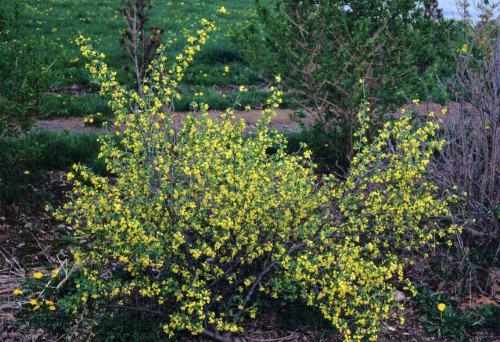Ribes odoratum
Clove Currant, Buffalo Currant
Saxifragaceae
ExpandHabitat
- native to the central United States, est of the Rocky Mountains
- zone 4
Habit and Form
- a deciduous shrub
- multistemmed
- rounded to irregular shape
- upright ascending branches that arch over
- typically produces numerous, vigorous sucker shoots
- somewhat loose and open
- 6' to 8' tall
Summer Foliage
- deciduous leaves in an alternate arrangement
- leaves have 3 to 5 large lobes
- leaf margins coarsely toothed
- leaf color is bluish-green
- petioles are relatively long
Autumn Foliage
- base color is yellow with red mixed in
- moderately showy
Flowers
- blooms in late April to early May
- small tubular yellow flowers in clusters to 5 to 10
- flowers somewhat nodding
- dioecious, with male and female plants
- flowers are very fragrant with a spicy, clove-like scent
Fruit
- a black berry
- 0.33" in diameter
- produced in July; only on female plant
Bark
- not ornamentally important
Culture
- easy to grow
- soil adaptable
- full sun is best
- tolerates shade
- can be rejunvenated with heavy pruning
Landscape Use
- shrub borders
- for fragrant flowers
- mass plantings
Liabilities
- somewhat difficult plant to keep looking tidy
- alternate host for white pine blister rust
- cannot be planted in some northern areas where white pine is plentiful due to quarantine laws
- leaf spot and mildew can cause early defoliation
ID Features
- clove-like fragrant yellow flowers
- blue-green 5-lobed leaves with long petioles
- ascending branches, eventually arching over
- basal suckering with vigorous shoots
Propagation
- by cuttings
- by seed
Cultivars/Varieties
f. xanthocarpum - This natural variant bears yellow fruit.
'Crandall' - Not commonly available, this cultivar was selected for its larger edible fruit and disease-resistant foliage.









